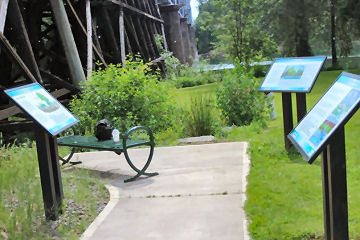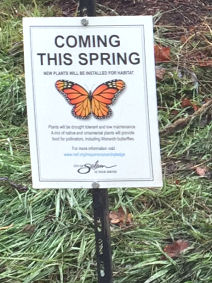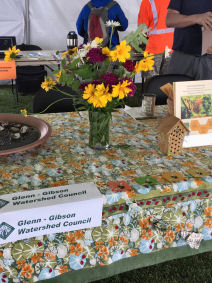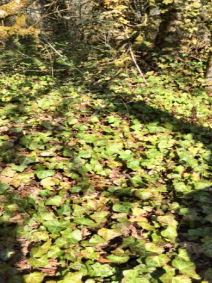GGWC Projects
Projects that are intended to improve water quality in our streams and rivers; to restore and conserve our natural habitats for fish and wildlife, and possibly help reduce flood risk through these efforts.
This information is part of the planning process to document the importance of floodplains to sensitive species and a way for the city to keep flood insurance premiums lower for Salem residents.
Click link for: Salem Floodplain Species Assessment
Retrofit of the Fish Ladder at Salemtowne Pond
The Salemtown Dam has long been a barrier to fish passage and it is low in the watershed. Gibson Creek is dammed just before it joins Glenn Creek. A fish ladder is in place but has been altered by high stream flows and has not allowed passage of juvenile Cutthroat Trout or access by steelhead for many years.
The Oregon Department of Fish and Wildlife is currently in the process of designing a way to retrofit the fish ladder to provide improved fish passage so all ages of fish have access to Glenn and Gibson Creeks for both migratory and resident Cutthroat Trout and Steelhead.
Glenn and Gibson Creeks Watershed Council is providing partial funding for this project through the Salem Electric Habitat Improvement Fund. The property owners have allowed access for the project and cooperated with the surveying for the design.
The Oregon Department of Fish and Wildlife is developing a design for the project that will be shared with the property owners when it is completed. If approved by the property owners, the installation will be cost shared by the watershed council.
Study of West Salem Streams ODF Fish Survey 1999
 Salemtowne
Dam headgates to fish ladder from pond
Salemtowne
Dam headgates to fish ladder from pond Fish
ladder top step view from above
Fish
ladder top step view from above Fish
ladder top step view from below
Fish
ladder top step view from below Willamette River Greenway Survey
To conduct a survey to evaluate current status and identify restoration opportunities for the Willamette River and floodplain on a segment of the river between the Willamette Mission/Windsor Island and Hayden Island.
Photos are taken on the Spingath Property along the floodplain of the Willamette River between Wallace Road and the Wallace Marine Park. The man in the picture is Curt Spingath. Janet and Curt Spingath are concerned about their floodplain property being preserved and protected as development occurs in West Salem.



Oak Savanna
To maintain and improve Oak Savanna and native Willamette Valley prairie habitats on this 14 acre parcel of City of Salem owned property. Partners are the City of Salem, Salem Electric (placed raptor poles) Salem Electric HIP program donors, and neighbors for observations of flora and fauna and eyes on the project for security.
City approved 2021 Master Plan



Wallace Marine Park Rain Garden
This project was designed to demonstrate the potential for green infrastructure. This rain garden collects, filters and stores the run off from the roof of the park bathrooms and both project and signage are clearly visible from the Union Street Railroad bridge walkway. Partners are the City of Salem and the donors to the Salem Electric HIP





Pollinator Gardens in Parks
The GGWC seeks to establish pollinator gardens in all West Salem city parks for increased habitat for pollinators, but equally, as education for property owners to increase pollinator habitat on their property and to increase awareness of the importance of pollinators and the fact that they are in rapid decline. Partners for this project include the City of Salem, Marion County, the Institute for Applied Ecology and the neighbors of Eola ridge Park for care and watering of the pollinator garden.




Invasive Species removal
Invasive species are a problem because they crowd out native plants and do not provide habitat for native species that depend upon native flora to survive. Invasive species targeted are English Ivy, Himalayan Blackberry Japanese Knotweed and Reed Canary grass. Partners are the City of Salem, property owners, the No Ivy coalition of Salem, Oregon. Our next project to remove English Ivy will take place at Holman State Park off Highway 22 on the ridge between the Rickreall Creek drainage and the West Slope drainages. This park contains a forest of large old Maple, Cottonwood and Cedar trees threatened by invasive English Ivy. The event will take place on July 16 and 17, utilizing the Youth Corps from the Grand Ronde tribe. Our partners will be the Oregon State Parks and Recreation, the Grand Ronde Youth Corps and Rickreall Watershed Council.
These photos demonstrate how English Ivy climbs trees, smothering them and weighing them down. On the ground, Ivy takes over and eliminates native plants.



Education and Outreach
GGWC attends as many events as possible for education and outreach. We partner with local schools for outdoor schools, field trips and study projects.




Turnage Brook Riparian Restoration Project
Turnage Brook flows through Eola Ridge Park and had no native riparian corridor vegetation. The project was to remove invasive English Ivy, Himalayan Blackberry and replant with native species.
View the report on the outcome of this project.
EOLA RIDGE PARK TURNAGE BROOK RIPARIAN CORRIDOR RESTORATION REPORT



Turnage Brook regrowing after restoration.
View the report on the outcome of this project.
EOLA RIDGE PARK TURNAGE BROOK RIPARIAN CORRIDOR RESTORATION REPORT
Audubon Nature Preserve
The challenge with the Audubon nature Preserve was the steep slope used by bikers and hikers alike, with the result that no plants were growing. GGWC provided horse logging to move in logs as an obstacle. The bikers used the logs as a jump, so clearly, another solution was called for. The solution turned out to be a fence, keeping the slope from further erosion, and the plants intact. Partners for this project include Salem Audubon Society.
First try to protect the slope...


The ultimate solution, protecting the slope from erosion and the plants from destruction.
Copyright Glenn-Gibson Watershed Council , All Rights Reserved.
